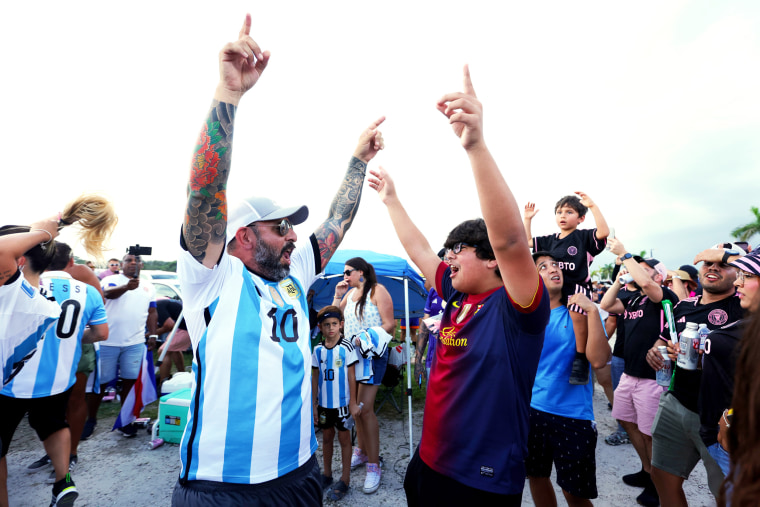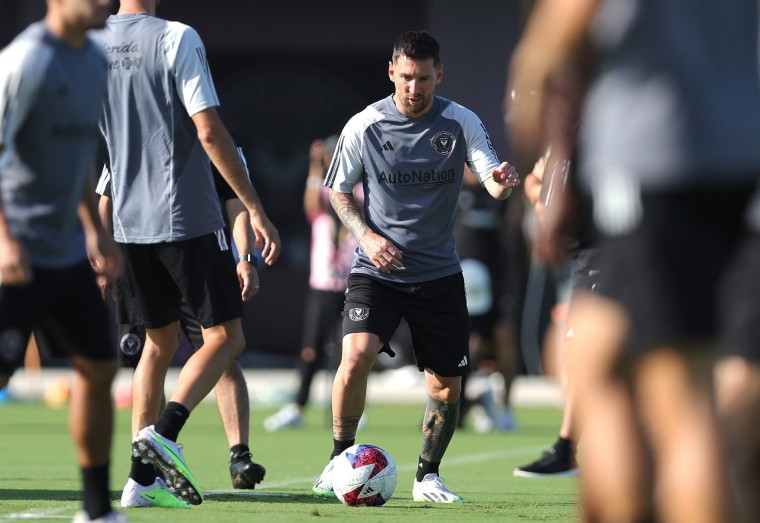MIAMI — Soccer superstar Lionel Messi began training with Inter Miami CF on Tuesday — and he managed to fill the team’s DRV PNK Stadium before even touching the ball.
Two days earlier, thousands of fans welcomed him to Miami and Major League Soccer in a ceremony complete with fireworks and musical performances.
“Just to be near him, you know, it’s like to be near God,” said Alfonso Sundblad, who flew from Buenos Aires, Argentina, to Miami, where his brother and family live, to watch the ceremony Sunday night.
Messi’s official debut with Inter Miami will be Friday against Mexican Liga MX team Cruz Azul.
Messi’s move to Miami less than a year after a historic and unforgettable victory for Argentina at the World Cup has inspired an outpouring of enthusiasm and pride in South Florida, particularly among its Argentinian and broader Latino communities. But it’s also a turning point for MLS, thrusting the league — and men’s soccer in the U.S. — to a level of global recognition it hasn’t yet dribbled in.
“It is a surprise because the MLS is, was not, like the Italian or English or Spanish tournaments, you know? This is really good news for the MLS because I think it’s going to bump it. It will bring the level up,” Sundblad said.

A 'seismic' impact
Pablo Maurer, a writer for The Athletic covering MLS, said Messi’s arrival in the league has the potential to create a far-reaching, “seismic” impact.
“All these leagues globally, they have a one-century head start on MLS. Soccer in America generally has a long way to go before it’s at that level,” Maurer said.
Maurer compared Messi’s arrival to the late Brazilian soccer icon Pelé’s joining the New York Cosmos, part of the North American Soccer League, in 1975.
“Back then soccer was really nothing to speak of in America, and Pelé made that team in that league a very big deal for a few years and sort of planted the seeds of soccer fandom,” Maurer said.
The state of soccer in the U.S. is already well established compared to when Pelé inherited it. MLS comprises 29 teams, and major European legends like Zlatan Ibrahimović, Thierry Henry, Steven Gerrard and more have arrived since then.
But the world’s best player didn’t just come to America: His new home, Miami, which some refer to as Latin America’s northernmost city, has a built-in fan base for whom soccer is more than just a sport.
Maria Carina Cortes, a Key Biscayne-based Realtor from Argentina who was also at the ceremony, said that after 28 years in the U.S. she no longer feels like she has the Argentinian flag “inside of my veins, in my blood.” But at the stadium Sunday, her patriotism was palpable.
“The Messi mania is crazy,” Cortes said. “It was unbelievable, everybody screaming ‘Messi! Messi! Messi!’ I had piel de gallina,” she said, using the Spanish phrase for “goose bumps.”

Despite MLS’ reputation as a place where players from Europe’s top leagues come to retire, the league has made significant gains in the last decade, including viewership, media rights and what it spends on players, Maurer said. Messi’s arrival will help move the needle to the next level in terms of profitability and notoriety.
Fans in America have had to look abroad for higher-caliber soccer teams, Maurer said. Whereas MLB, the NFL, the NBA and other professional sports compete against one another, MLS competes against every professional soccer league on multiple continents.
While MLS has at times struggled to connect with its Latino fan base, the sport’s explosive growth in the past decade has coincided with the growth of the Latino population in the U.S. Inter Miami itself is co-owned by Jorge Mas, a Cuban American billionaire, and his brother Jose, as well as soccer icon David Beckham.
Gladys Arneri, who owns an Argentinian restaurant, Milanezza, in Key Biscayne, said last year many of her fellow Argentinians flocked to her restaurant to watch the World Cup final. The restaurant’s namesake dish, milanesa, is known to be a favorite of Messi’s.
“We are so glad that he’s here. … You can see that he’s enjoying his time here with his family,” Arneri said, referring to viral photos of Messi settling into Miami and, most recently, shopping at a Publix supermarket. “For us, Messi is like part of our family. … So having him here, it’s something that is amazing."
Messi’s multicultural appeal has energized the city and attracted more international star power to the team. His ex-Barcelona teammate Sergio Busquets also joined Inter Miami, and Jordi Alba is expected to sign soon, Inter owners Mas and Beckham recently told The Miami Herald.
“This is America. It sort of should be diverse and multicultural,” Maurer said, noting that Messi is widely known for not speaking English and for doing media interviews in Spanish.
“He’s the world’s best Latino player because he’s the world’s best player,” Maurer said. “It’s very much a huge moment for MLS. I think now it’s just going to be about how do they seize it.”
Isabela Espadas Barros Leal reported from Miami and Edwin Flores from Anaheim, California.

